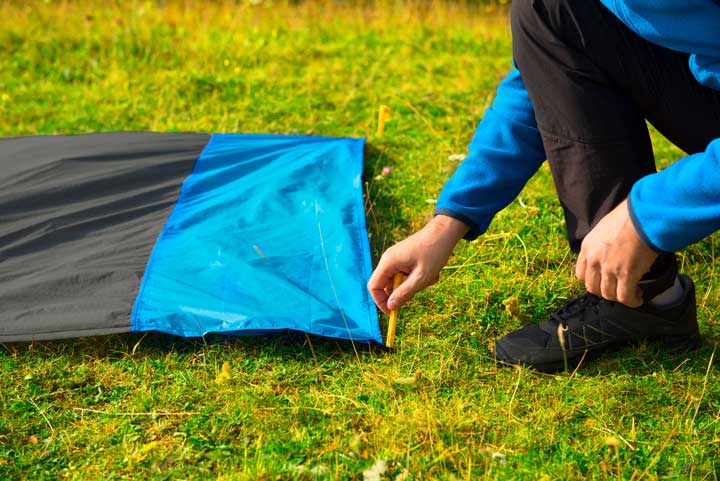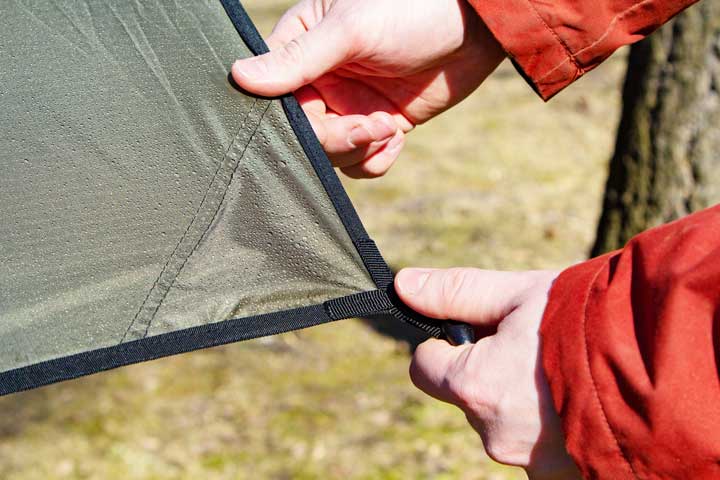A typical camping trip often involves a lot of gear, which can be heavy and expensive. Sometimes you have to make difficult choices on what to bring, what to buy, and what to make. One essential piece of equipment to prolong the life of your gear is a tent footprint.
Is a tent footprint something you have to buy pre-made? Can you make one yourself? Do you need one at all? Here’s everything you need to know to decide.
Summary
Do I need a tent footprint? Yes, but there’s no reason to pay extra for a purpose-made tent footprint. You can easily repurpose other items you may already have at home without sacrificing any protection for your shelter.
An Overview of Tent Footprints
Before you decide whether you need a tent footprint, it’s essential to understand what a tent footprint is and how it can make your camping experience better.
What does a tent footprint do for a tent?
A tent footprint creates a waterproof barrier between the bottom of your tent and the ground beneath it. Why is this necessary? The floor of your tent is fragile. As you’re sitting, lying, or moving around inside, your tent will slide over the ground.
This friction can cause abrasions, snags, and tears in your tent’s material. This will shorten the life of your tent overall and could lead to some pretty unpleasant camping experiences if you don’t notice it right away.
A tent footprint takes the bulk of the friction, protecting the bottom of your tent from rocks, sticks, and other debris. It also blocks moisture from the ground from seeping up through the floor of your tent. Proper use of a tent footprint can prolong the life of your tent and save you money.

What can I use instead of a tent footprint?
You can use just about any waterproof material as a tent footprint. A cheap plastic tablecloth, a polyethylene sheet from your local hardware store, or a standard tarp will work nicely. In addition, you can use a few cheap and simple products to further waterproof your tent.
Can I use a tarp as a tent footprint?
You can use a tarp as a tent footprint. These are generally heavier than a purpose-made tent footprint from an outdoor retailer, but they’re versatile enough that the extra weight is more than worth it.
Why do people put a tarp under their tent?
Campers and backpackers put tarps under their tents to block moisture from seeping up from the ground through the bottom of their tent throughout the night. A tarp also prevents holes, rips, and tears in the bottom of your tent by protecting it from sticks, rocks, and friction.
Do I need to put a tarp under my tent?
Is it always necessary to put a tarp or other footprint under your tent? I guess not, strictly speaking, but it’s always a very good idea to do so. If the ground is dry and you’re confident it’s free of debris, there may not be much risk of damage to the bottom of your tent.
But if you want your tent to last as long as possible (and who doesn’t?), you should have some sort of barrier between the floor of your tent and the ground you pitch it on. It’s impossible to detect everything that could damage your tent, and it’s better to protect your equipment than to risk damaging it.
In addition, adding a tarp under your shelter is a great way to add insulation to your tent.

How do you make a homemade tent footprint?
To make a homemade tent footprint, take any piece of waterproof fabric or material and lay it out. Measure the bottom of your tent, and mark the material to show the size of your tent. Cut or fold slightly inside this line to make your homemade tent footprint somewhat smaller than your tent. That’s all there is to it!
If your homemade footprint is only used as a footprint, you’ll likely want to cut rather than fold, to save on space and weight. However, if you’re using a tarp, it’s better to fold so that the tarp retains its usability for other things.
What size footprint do I need for my tent?
Your tent footprint should be slightly smaller than the floor of your tent. If your footprint is larger than the floor of your tent, it will collect dew and rain, and channel it under your tent.
Some tents come with a pre-made tent footprint, or you can buy purpose-made tent footprints sized to fit standard tent sizes. Doing this will save you the extra legwork of cutting or folding it to fit your tent before camping.
Is it worth buying a tent footprint?
Is it worth it to buy a tent footprint? That depends on what kind of tent footprint you purchase and what type of camping you do. There are purpose-made tent footprints for sale from outdoor retailers. I would say that, in general, it’s not worth buying one of these unless you often camp on very rough terrain.
In general, a purpose-made tent footprint will do the same thing as a homemade or multipurpose footprint. The only additional features that typically come with a store-bought footprint are (a) webbing and grommets to help with staking and (b) pre-cut to size to save you any prep work.
If you already have a tarp or can buy something inexpensive like a tablecloth, there’s no reason to spend more money on a purpose-made tent footprint for your typical camping adventure. If, on the other hand, you camp on rougher terrain, a tent footprint is not prohibitively expensive, so that it may be worth it to you.
Conclusion
With all that in mind, is it necessary to use a tent footprint? Yes, if you want to extend the life of your tent. However, unless you’re often camping on very rough terrain, a purpose-made tent footprint is not strictly necessary. You can easily make your own from materials you likely already have on hand, including a tarp, which can be used for other things.




